
Background information
Aquafit for dogs: a visit to the animal physio
by Darina Schweizer

The Veterinary Hospital (Tierspital) in Zurich treats over 28,000 animals every year. During my visit, I was amazed to learn about customised prostheses, faecal transplants and the things that end up in dogs’ stomachs.
A Newfoundland dog’s sat under the reception counter, it’s tongue dripping. Behind him, there’s a husky limping through the sliding door. The meowing of a Chartreux cat sitting in a transport box fills the waiting room. It’s a full house this Tuesday morning at the Veterinary Teaching Hospital Zurich.
As I watch the animals come and go, my imagination runs wild. Will an elephant be sticking its trunk through the door next? After all, the animal hospital also treats zoo animals. It’s the first thing I ask medical director Jean-Michel Hatt when he picks me up for a tour of the hospital. He laughs and says:
«Yes, one time an elephant was brought to us from France by semi-trailer truck. But most of the time, our vets go to the zoo.»
Elephants, lions, horses, cows, pigs, dogs, cats, meerkats, degus, zebra finches: the Veterinary Hospital takes care of all kinds of patients – from five grammes to five tons. I’m here for the little ones. The largest department in the hospital is reserved for them. Around 14,000 dogs and 6,000 cats are treated at the small animal clinic every year.
I realise how much space this takes up as we walk up the long staircase and all the way down the seemingly endless corridor. Gastroenterology, cardiology, dermatology, dialysis, neurology – every special field for humans is also available for animals. Even the clinic equipment largely stems from paediatric medicine – the devices are the perfect size. I’m itching to take a peek behind the doors. And I’ll be able to do that any minute. Jean-Michel Hatt hands me over to Sebastian Knell, Senior Consultant in small animal surgery.
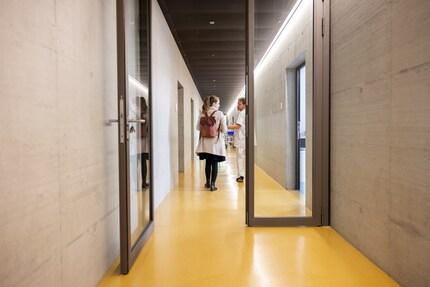
I follow him into the anaesthesia room. A handful of employees are anaesthetising two tiny bundles of fur. One of them’s a Chihuahua with hydrocephalus, or what used to be referred to as water on the brain. But in fact, it’s an accumulation of cerebrospinal fluid and not water. It’s a common disease in dwarf breeds. The other bundle’s a mongrel that has suffered trauma – possibly from a fall from a balcony or a collision with a car. However, other issues are more common. Most animals, many of them purebred, have orthopaedic problems, says Sebastian Knell. Depending on the type of breed, other joints are affected:
«In dogs, we mainly see herniated discs in French Bulldogs and elbow dysplasia in Labradoodles. In cats, hip and kneecap problems are prevalent in British Shorthairs and Maine Coons.»

Speaking of which, a French Bulldog with a neck brace has just arrived. He’s sitting in a small adjoining room, visibly dazed. The anaesthetic seems to be working. But why’s he next door? «There’s not enough space,» says Sebastian Knell. The Veterinary Hospital’s bursting at the seams. This is mainly due to the growing number of pets and the needs of their owners. «In the past, animals were euthanised sooner, but today owners can afford expensive treatments.» This is possible thanks to ever-improving medical possibilities.
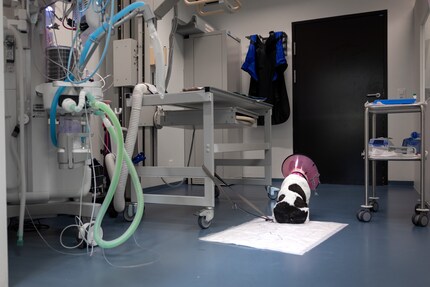
Sebastian Knell shows me what this means in concrete terms a few rooms down. There, surgeons are inserting a hip prosthesis into a German Shepherd. Not a standard model as would’ve been the case a few years ago, but a customised 3D reconstruction. I’m amazed. «Can you do this for every type of joint?» I want to know. «In theory, yes. But so far, hip prostheses are the standard procedure. We only use knee and elbow prostheses very sporadically.»
According to Sebastian Knell, sports injuries in particular have increased. These are caused by the dog sport agility, for example. «Border Collies often injure their shoulders when running slaloms,» the senior physician explains. Recovery therapy, which can be done in the clinic’s own physiotherapy department, for example, is particularly important in these cases. However,
«I often need to persuade the owners to put their pets in physio. Many owners don’t have insurance and would rather do without the aftercare. But it’s cutting costs in the wrong place.»
Pet owners often have to dig deep into their pockets for specialised treatments. As we walk past the oncology department, Sebastian Knell reveals that reconstructive surgery for cancer patients is one of the most complex procedures. «Inserting a titanium sternum in a cat is highly challenging.»
The traits of certain breeds can also further complicate treatment. It’s almost impossible to make a lively Bengal cat rest its knee after an operation. Border Collies also struggle to sit still and need to be distracted with mental challenges. «Labrador’s are easier. They’re not too bothered about moving and prefer to eat,» says Sebastian Knell and laughs.

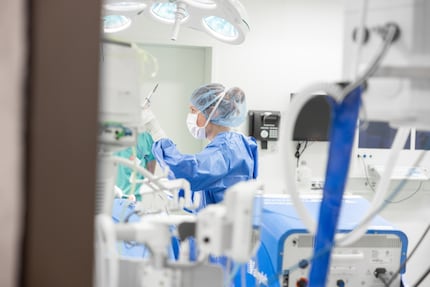
An insatiable appetite is often the reason four-legged friends are admitted to the Veterinary Hospital Zurich. Even though fewer and fewer animals are dying during surgery, poisoning is the most common cause of death. According to Sebastian Knell, people often underestimate how dangerous seemingly harmless foods can be.
«Many people know that chocolate is poisonous for dogs. But this also applies to onions, grapes and medicines such as aspirin. On top of this, antifreeze is tempting to cats because it’s sweet.»
Sebastian Knell and his team have extracted all sorts of things from animal stomachs: sawdust, barbecue skewers, epilation wax, Migros collectible figurines. One time, it was an unfamiliar pair of women’s knickers that put one husband on the spot. Looks like the dog was trying to destroy evidence.
The Veterinary Hospital mainly treats illnesses and ailments, but also provides preventative care. Last summer, it launched the Growing Dog Project (page in German). The aim is to catch diseases early on. How it works is that dogs come in for regular checkups from birth to the end of their life. Specialists at the animal hospital check the animal’s diet and vaccination status, carry out a thorough clinical examination and take blood, mucous membrane, urine and faecal samples. The main person in charge is Stefan Unterer, Director of the Clinic for Small Animal Medicine, specialising in gastroenterology. He says:
«We suspect that antibiotic treatments in young dogs can later lead to chronic intestinal disease, among other things.»

Good results for intestinal diseases have already been achieved by hospital with faecal transplants from donor animals. What sounds disgusting is actually really effective. Excrement contains a large number of microbes, i.e. useful bacteria, which can bring the intestines of a sick animal back into balance. «We’re also increasingly moving away from deworming and vaccination as standard. It makes more sense to test antibodies and give the animals customised vaccinations. Our motto is: As much as necessary, as little as possible,» says Stefan Unterer.
50 dogs have joined the Growing Dog Project to date. One of them is Maltipoo Joy. Her owner Sarah Frutiger has brought in the dog for a checkup with Stefan Unterer that morning. «My dog trainer told me about it. I thought it would be good to help research,» she says.
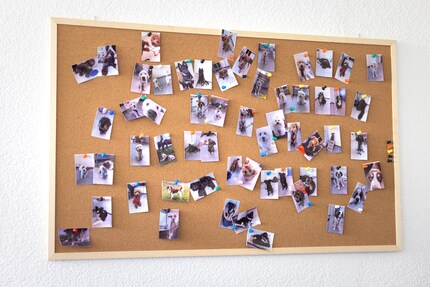

Joy has already undergone a dietary consultation. So what are the things to look out for? Nutritionist and veterinarian Freya Moscoso, who’s present at the examination, says:
«Choosing a good food manufacturer’s important. These are mostly larger companies that also invest money in their own research. For special feeding methods such as biologically appropriate raw foods, or BARF for short, you need the rations to be calculated a professional.»
Joy’s as fit as a fiddle. After a quick check of the blood, teeth, ears and eyes, all postgraduate vet Dajana Birk has to do is remove a few ticks. The majority of the remaining 49 puppies in the research project are also doing well. There’s just one puppy with high liver enzyme values. «We found out that he has a congenital liver malformation and lacks a gall bladder,» says Stefan Unterer. «He’s now receiving preventive care which should hopefully allow him to lead a healthy life. This is a first small triumph.»
Stefan Unterer recently experienced the biggest breakthrough with a new drug developed by researchers in the USA. It’s for fighting Feline Infectious Peritonitis (FIP). «Cats used to die from it after one to two weeks. Now we can cure them all,» he says. The only problem is the drug isn’t on the market yet. «As soon as we have enough data to confirm the safety of the drug, we hope to obtain approval in Europe.» This is unlike Joy, who’s provided enough data for today. She leaves the examination room with Sarah Frutiger, happily wagging her tail.
Some patients in the recovery room of the small animal clinic are also about to be discharged. A Bengal cat with a half-shaved back, peering wistfully through the bars, can hardly wait. A few boxes down, there’s a Chartreux cat with a bandaged front leg meowing. No way! It’s the same one I saw in the reception area of the small animal clinic earlier. «Get well soon,» I wish the patient and make my way home too.
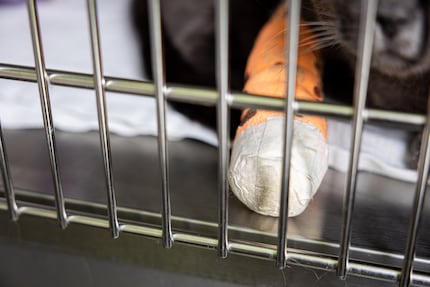
I love anything with four legs or roots - especially my shelter cats Jasper and Joy and my collection of succulents. My favourite things to do are stalking around with police dogs and cat coiffeurs on reportages or letting sensitive stories flourish in garden brockis and Japanese gardens.
Interesting facts about products, behind-the-scenes looks at manufacturers and deep-dives on interesting people.
Show all
Background information
by Darina Schweizer

Background information
by Janina Lebiszczak

Background information
by Darina Schweizer